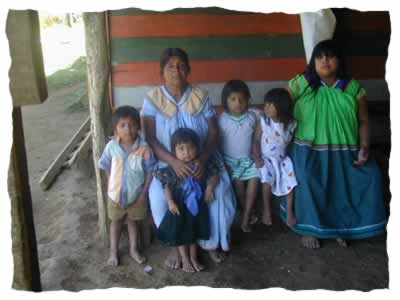Guaymi Indigenous Reservation
Guami Indigenous Reservation
Nowadays, in Costa Rica there are 8 different indigenous groups, each with their own language, traditions, life style and geographic location. Some of these groups preserve their traditions, others have lost their cultural identity due to the effect of colonization, the breaking of agricultural boundaries, integration, and the influence of urban centers. Now there are approximately 27.000 indigenous habitants in Costa Rica.
The Guaymies are distributed in four reservations:
1. Coto Brus : Villa Palacios, Caño Bravo and Limoncito towns.
2. Abrojos, Montezuna en Corredores, algunos pueblos guamíes son Bajo Los Indios, San Rafael Abrojos, Montezuma y Bellavista.
3. Conteburica: Corredores and Golfito, La Vaca, El Progreso, Santa Rosa, Río Claro, Las Gemelas, Los Plancitos, towns, amoung others.
4. Guaymí de Osa, it limits with Corcovado National Park, located between Quebrada Pavón and Río Riyito in Dos Brazos de Osa.
POPULATION AND ECONOMY
On the four reserves there is a total of 4.150 inhabitants.
 The Guaymie community cultivates cocoa, coffee, corn, palm and plantains. They combine their agricultural activities with other indigenous groups in the raising of pigs and birds, in hunting, as well as in fishing (with skillful use of bow and arrow).
The Guaymie community cultivates cocoa, coffee, corn, palm and plantains. They combine their agricultural activities with other indigenous groups in the raising of pigs and birds, in hunting, as well as in fishing (with skillful use of bow and arrow).
CULTURE
The Guaymie people, preserve their traditional customs, characteristics and clothes.Women make characteristic hats from a certain tree's bark. Their colorful traditional costumes are unique to the Guaymie culture.
They mainly use natural fibers, vegetable dyes and colors. Some of the main products are "chácaras" (Crá), traditional hats and typical dresses made with beautiful colors and handsewn geometrical figures.
Their language is Guaymie (Ngobe) but some of the leaders and chiefs also Speak Spanish. A bilingual literacy program has been started.
Guaymie crafts are based on making articles from natural leaves and fibers. They prepare natural inks from plants, especially in black.
The commonly used musical instruments are:
• Ocarina-Mugata- Dru: used in the Balsería.
• Drú Noara
• Oruc-Caracol
• Toleró
• Ton
• Yusa
LEGAL STATUS
In 1986, the National Commission of Indigenous Matters ( Comisión Nacional de Asuntos Indígenas -CONAI- ) completed an arduous work to grant residence to these natives. The objective was to carry out a census and to give them nationality as well as their respective identification cards. It also recognizes their indigenous identity, their traditions and their customs. These Indians are declared Costa Ricans by means of the Law #7225 in 1991.
HOUSING
Guaymie people build their houses, called ranchos, at ground level with walls of sticks and roofs of palm with a rectangular shape. The "ranchos" are built some distance apart. Sometimes, they build two houses, one for the rainy season on higher ground and the other at lower ground.
Cookers are built on tables with 3 or 6 stones on which they place big pots with firewood beneath. They also make bonfires outside the house with stones in the ground and 3 tree trunks in between.They hang food in bags they make themselves. They also use general domestic implements, such as pots, pans and jugs, and eat large amounts of rice, the principal element of their diet.
RELIGION
The Guaymie believe in their own god (Nubu) and practice "Mama chi", a cult with a lot of followers based on the apparition of the Virgin, witnessed by an indigenous women who became the principal leader of the doctrine. They are associated with many religious groups. Nonetheless they maintain their own beliefs regarding birth, death, puberty and marriage.
Once a year or on special occasions, they participate in traditional dances and gatherings. The Balseria is the main event, combining friendship, rivalry and competition. They drink home made liquor, and eat food. Using sticks of balsa wood they compete in groups or individually, facing each other. Traditional costumes are worn, they paint their faces and adorn their heads with feathers.
The idea of the competition is to hit the opponent’s ankles and cause, sometimes, large wounds. The winner gains possession of the women, who participate as spectators.
COMMUNICATION ROADS
These reservations have difficult access. Their population is dispersed and they commute by foot trails. They have to walk a lot to arrive at the central places. Due to this isolation, they have few services.
SERVICES
This population has had the attention of the Ministry of Health. It is known that the most frequent illnesses are: fevers, rheumatic pains, teeth problems, malnutrition and lack of hygiene.
Because they have a high illiteracy problem, there are bilingual programs that CONAI coordinates. This institution also offers attendance in productive projects.
VILLA PALACIOS INDIGENOUS COMMUNITY MUSEUM (GUAYMI TRADITIONAL CULTURE)
LOCATION: This Guaymi Indigenous Reservation is in Villa Palacios, part of Coto Brus county in Puntarenas. It´s 7 kms. from Sabanilla on the road to San Vito.
It opens everyday from 8 a. m. to 5 p. m..
The objectives of this museum are to revive the traditional Guaymi architecture, which is reflected in the museum building, and to rescue the Guaymi culture with emphasis on the production of handicrafts and medicinal plants.
The museum is the center for community activities dedicated to revitalizing their traditions like oral history, recounting, use of the Guaymi language, dances, and celebrations.
Within the museum, traditional Guaymi crafts are made and sold. Additionaly, cultural and educational activities involving the whole community are programmed. Permanent exhibitions have examples of handcrafted items like those found in Guaymi ranchos, which show part of the indigenous life style, their local products and traditions.
Be the first to comment on this listing!